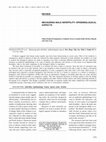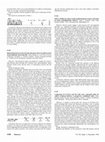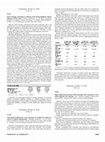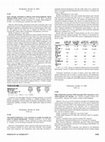Papers by Christiany Locambo
Brazilian Journal Urology, 2001

Revista do Hospital das Clínicas, 2003
Evidence suggests that human semen quality may have been deteriorating in recent years. Most of t... more Evidence suggests that human semen quality may have been deteriorating in recent years. Most of the evidence is retrospective, based on analysis of data sets collected for other purposes. Measures of male infertility are needed if we want to monitor the biological capacity for males to reproduce over time or between different populations. We also need these measures in analytical epidemiology if we want to identify risk indicators, risk factors, or even causes of an impaired male fecundity-that is, the male component in the biological ability to reproduce. The most direct evaluation of fecundity is to measure the time it takes to conceive. Since the time of conception may be missed in the case of an early abortion, time to get pregnant is often measured as the time it takes to obtain a conception that survives until a clinically recognized pregnancy or even a pregnancy that ends with a live born child occurs. A prolonged time required to produce pregnancy may therefore be due to a f...

Fertility and Sterility, 2003
normally (61%). There was an equal distribution of embryos in both groups based on cell stage, an... more normally (61%). There was an equal distribution of embryos in both groups based on cell stage, and percent fragmentation. Fourteen patients achieved pregnancy (50%) after transferring 30 blastocysts. The results are summarized in Table 1. Conclusions: Blastocyst development rates (and blastocyst quality) were similarly high in both the AT group and in LAH group, indicating that laser hatching does not impair embryonic development to the blastocyst stage. Implantation rates were not compared because patients often had a combination of AT and LAH embryos used for transfer. Given that an equal number of LAH and AT embryos were transferred resulting in a 50% pregnancy rate, the data suggests that zona drilling by laser micro-beam does not produce additional risks for embryonic development beyond the blastocyst stage. Additionally, the results of the present study demonstrate that LAH is a suitable alternative to the use of acidified Tyrode's solution for zona drilling. P-229 Relationship between early cleavage and sperm source in embryos from intracytoplasmic sperm injection.
Fertility and Sterility, 2005

Fertility and Sterility, 2003
Objective: More recently, assessment of the time of cleavage to the 2-cell stage has proven to be... more Objective: More recently, assessment of the time of cleavage to the 2-cell stage has proven to be a reliable parameter for the selection of embryos with the highest capability of implantation and successful pregnancy after transfer. The purpose of this work was to compare the relevance of early cleavage (EC) under embryo development and pregnancy occurrence. Design: Propsective in vitro study. Materials and Methods: This prospective study included 147 ICSI cycles (122 patients). Several classifications were done in the same embryos since fertilization diagnosis until time to transfer. All zygotes that were normally fertilized (two pronuclei) were included. Seventeen hours after ICSI, the pronuclear (PN) and nucleolar precursor body (NPB) arrangement were evaluated. Normal embryos (S0) showed aligned or aligning PN, with no discrepant number of NPB compared between male and female PN. Embryos with different conditions were classified as abnormal (S1). Early cleavage assessment was done, as a rule, 26 hours after ICSI. Three groups were formed: (A) embryos with visible PN; (B) embryos non-cleaved without visible PN and (C) EC-embryos. Embryo selection was performed on day 3 according to number, size, shape of cells and fragmentation. "Good quality embryos" was classified when had regular blastomeres, with at least 6 cells and without fragmentation on day 3. "Top quality embryos" were named when good quality embryos showed also S0 classification. It should be noted that embryos were not selected for transfer on the basis of early cleavage occurrence. Statistical significance was determined using Student's t test, chi-square and Fisher's exact tests as appropriate with statistically significant differences considered at p Ͻ 0.05. Results: The mean maternal age (SD) was 36.4 (5.5) and did not differ among three groups (34.5 Ϯ 4.6; 34.1 Ϯ 5; 34.2 Ϯ 4.2; groups A, B and C; respectively; p Ͼ .05). A total, 1203 viable oocytes were obtained after ICSI and of these, 74.3% had shown normal fertilization (n ϭ 894) and were analyzed. The presence of EC embryos in ICSI cycles seemed to predict the occurrence of pregnancy in cycles that provided 1 or 2 EC embryos (40%) and more than 3 EC embryos (56.1%). Irrespective of other classifications (PN or day 3 morphology), when at least one EC embryo was transferred, pregnancy occurred in 60% of patients, two times higher than that obtained without the transfer of these kind of embryos (33%; p ϭ 0.025). Complementary results are shown in the table.

Fertility and Sterility, 2003
Objective: More recently, assessment of the time of cleavage to the 2-cell stage has proven to be... more Objective: More recently, assessment of the time of cleavage to the 2-cell stage has proven to be a reliable parameter for the selection of embryos with the highest capability of implantation and successful pregnancy after transfer. The purpose of this work was to compare the relevance of early cleavage (EC) under embryo development and pregnancy occurrence. Design: Propsective in vitro study. Materials and Methods: This prospective study included 147 ICSI cycles (122 patients). Several classifications were done in the same embryos since fertilization diagnosis until time to transfer. All zygotes that were normally fertilized (two pronuclei) were included. Seventeen hours after ICSI, the pronuclear (PN) and nucleolar precursor body (NPB) arrangement were evaluated. Normal embryos (S0) showed aligned or aligning PN, with no discrepant number of NPB compared between male and female PN. Embryos with different conditions were classified as abnormal (S1). Early cleavage assessment was done, as a rule, 26 hours after ICSI. Three groups were formed: (A) embryos with visible PN; (B) embryos non-cleaved without visible PN and (C) EC-embryos. Embryo selection was performed on day 3 according to number, size, shape of cells and fragmentation. "Good quality embryos" was classified when had regular blastomeres, with at least 6 cells and without fragmentation on day 3. "Top quality embryos" were named when good quality embryos showed also S0 classification. It should be noted that embryos were not selected for transfer on the basis of early cleavage occurrence. Statistical significance was determined using Student's t test, chi-square and Fisher's exact tests as appropriate with statistically significant differences considered at p Ͻ 0.05. Results: The mean maternal age (SD) was 36.4 (5.5) and did not differ among three groups (34.5 Ϯ 4.6; 34.1 Ϯ 5; 34.2 Ϯ 4.2; groups A, B and C; respectively; p Ͼ .05). A total, 1203 viable oocytes were obtained after ICSI and of these, 74.3% had shown normal fertilization (n ϭ 894) and were analyzed. The presence of EC embryos in ICSI cycles seemed to predict the occurrence of pregnancy in cycles that provided 1 or 2 EC embryos (40%) and more than 3 EC embryos (56.1%). Irrespective of other classifications (PN or day 3 morphology), when at least one EC embryo was transferred, pregnancy occurred in 60% of patients, two times higher than that obtained without the transfer of these kind of embryos (33%; p ϭ 0.025). Complementary results are shown in the table.
Fertility and Sterility, 2003
Fertility and Sterility, Volume 80, Issue null, Pages 103, September 2003, Authors:Assumpto Iacon... more Fertility and Sterility, Volume 80, Issue null, Pages 103, September 2003, Authors:Assumpto Iaconelli; Lia M Rossi; Patrı́cia Guilherme; Claudia C Rocha; Christiany Locambo; Edson Borges. ...
Fertility and Sterility, 2003
Fertility and Sterility, Volume 80, Issue null, Pages 103, September 2003, Authors:Patrı́cia Guil... more Fertility and Sterility, Volume 80, Issue null, Pages 103, September 2003, Authors:Patrı́cia Guilherme; Lia M Rossi; Assumpto Iaconelli; Claudia C Rocha; Christiany V Locambo; Edson Borges. ...
Fertility and Sterility, 2003
normally (61%). There was an equal distribution of embryos in both groups based on cell stage, an... more normally (61%). There was an equal distribution of embryos in both groups based on cell stage, and percent fragmentation.
Uploads
Papers by Christiany Locambo